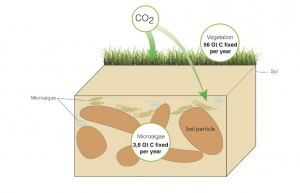Jassey, V. E. J., Walcker, R., Kardol, P., Geisen, S., Heger, T., Lamentowicz, M., Hamard, S., & Lara, E. 2022. Contribution of soil algae to the global carbon cycle. New Phytol, 234(1), 64–76. DOI: 10.1111/nph.17950
Soil algae capture around 3.6 gigatonnes of carbon per year, which is equivalent to 30% of man-made carbon dioxide emissions - have been determined by scientists from an international consortium to which the Adam Mickiewicz University in Poznań belongs. The results of the study were published in New Phytologist. Soil algae are a group of phototropic microorganisms that need light for their development. These include, among others, cyanobacteria. There are on average about 5 million microscopic algae in every gram of topsoil. Like plants, they absorb CO2 from the atmosphere, thereby increasing the carbon pool in the soil.
There are roughly 5 million microscopic algae, on average, in each gram of topsoil, according to a study published in The New Phytologist on February 1, 2022 and involving scientists from the Laboratoire Écologie Fonctionnelle et Environnement (CNRS / INP Toulouse / Université Toulouse III–Paul Sabatier), the Department of Forest Ecology and Management of the Swedish University of Agricultural Sciences, the Laboratory of Nematology of Wageningen University, the Department of Terrestrial Ecology of the Netherlands Institute of Ecology, the University of Applied Sciences of Western Switzerland, the Climate Change Ecology Research Unit at Adam Mickiewicz University (Prof. Mariusz Lamentowicz), and the Real Jardín Botánico of Madrid. Soil abounds with microscopic algae. Like plants, they sequester atmospheric CO2, thereby adding to the soil carbon pool. In order to better understand the global distribution of these terrestrial algae and predict their annual productivity using a machine learning model, the team of researchers collated data from the literature on these microorganisms. They found that soil algae capture approximately 3.6 gigatonnes of carbon annually, equivalent to 30% of CO2 emissions due to human activity. These results alter basic assumptions on the role played by microorganisms in the soil, showing that microbial photosynthesis is a major component of not only aquatic ecosystems but also most terrestrial ones, and they underscore the critical role of microalgae in the global carbon cycle. Preserving soil biodiversity has never been as important as it is today, when there is a growing urgency to seize all opportunities for reducing atmospheric CO2 levels.
